A Synergy Approach to Enhance Upconversion Luminescence Emission of Rare Earth Nanophosphors with Million-Fold Enhancement Factor
Abstract
:1. Introduction
2. Materials and Methods
2.1. Chemicals
2.2. Synthesis of NaYF4:Yb3+,Tm3+ Core UCNPs
2.3. Synthesis of NaYF4:Yb3+,Tm3+@NaYF4:Yb3+,Nd3+ Core@Shell UCNPs
2.4. Synthesis of NaYF4:Yb3+,Tm3+@NaYF4:Yb3+,Nd3+@NaYF4 Core@Shell@Shell UCNPs
2.5. Fabrication of UCNPs Deposited Low-n RWG Structure
2.6. UCL and Lifetime Measurement
2.7. Simulations
2.8. Characterizations
3. Results and Discussions
3.1. Characterization of UCNPs
3.2. Nanoparticles Engineering for Enhancing UCL Intensity
3.3. Photonic Engineering for Enhancing UCL Intensity
3.4. Overall Enhancement Factor of All the Strategies Combined
4. Conclusions
Supplementary Materials
Author Contributions
Funding
Conflicts of Interest
References
- Wang, F.; Liu, X. Recent advances in the chemistry of lanthanide-doped upconversion nanocrystals. Chem. Soc. Rev. 2009, 38, 976–989. [Google Scholar] [CrossRef]
- Zhang, F. Photon Upconversion Nanomaterials; Springer: Berlin/Heidelberg, Germany, 2015. [Google Scholar]
- Wu, S.; Butt, H.J. Near-infrared-sensitive materials based on upconverting nanoparticles. Adv. Mater. 2016, 28, 1208–1226. [Google Scholar] [CrossRef]
- Auzel, F. Upconversion and anti-Stokes processes with f and d ions in solids. Chem. Rev. 2004, 104, 139–174. [Google Scholar] [CrossRef]
- Auzel, F. History of upconversion discovery and its evolution. J. Lumin. 2020, 223, 116900. [Google Scholar] [CrossRef]
- Anderson, R.B.; Smith, S.J.; May, P.S.; Berry, M.T. Revisiting the NIR-to visible upconversion mechanism in β-NaYF4:Yb3+,Er3+. J. Phys. Chem. Lett. 2014, 5, 36–42. [Google Scholar] [CrossRef] [PubMed]
- Haase, M.; Schafer, H. Upconverting nanoparticles. Angew. Chem. Int. Ed. 2011, 50, 5808–5829. [Google Scholar] [CrossRef] [PubMed]
- Chen, G.; Qiu, H.; Prasa, P.N.; Chen, X. Upconversion nanoparticles: Design, nanochemistry, and applications in theranostics. Chem. Rev. 2014, 114, 5161–5214. [Google Scholar] [CrossRef] [PubMed]
- Zhou, J.; Liu, Q.; Feng, W.; Sun, Y.; Li, F. Upconversion luminescent materials: Advances and applications. Chem. Rev. 2015, 115, 395–465. [Google Scholar] [CrossRef] [PubMed]
- Chen, C.; Li, C.; Shi, Z. Current advances in lanthanide-doped upconversion nanostructures for detection and bioapplication. Adv. Sci. 2016, 3, 1600029. [Google Scholar] [CrossRef] [Green Version]
- Lin, M.; Zhao, Y.; Wang, S.Q.; Liu, M.; Duan, Z.H.; Chen, Y.M.; Li, F.; Xu, F.; Lu, T.J. Recent advances in synthesis and surface modification of lanthanide-doped upconversion nanoparticles for biomedical applications. Biotechnol. Adv. 2012, 30, 1551–1561. [Google Scholar] [CrossRef]
- Zheng, W.; Huang, P.; Tu, D.; Ma, E.; Zhu, H.; Chen, X. Lanthanide-doped upconversion nano-bioprobes: Electronic structures, optical properties, and biodetection. Chem. Soc. Rev. 2015, 44, 1379–1415. [Google Scholar] [CrossRef]
- Zhou, J.; Liu, Z.; Li, F. Upconversion nanophosphors for small-animal imaging. Chem. Soc. Rev. 2012, 41, 1323–1349. [Google Scholar] [CrossRef]
- Zhou, B.; Shi, B.; Jin, D.; Liu, X. Controlling upconversion nanocrystals for emerging applications. Nat. Nanotechnol. 2015, 10, 924–936. [Google Scholar] [CrossRef]
- Vu, D.T.; Le, T.T.V.; Hsu, C.C.; Lai, N.D.; Hecquet, C.; Benisty, H. Positive role of upconversion nanophosphors on resonant surfaces for ultra-compact filter-free bio-assays. BioMed Opt. Express 2021, 12, 1–19. [Google Scholar] [CrossRef]
- Vu, D.T.; Vu Le, T.T.; Nguyen, V.N.; Le, Q.M.; Wang, C.R.C.; Chau, L.K.; Yang, T.S.; Chan, M.W.Y.; Lee, C.I.; Ting, C.C.; et al. Gold nanorods conjugated upconversion nanoparticles nanocomposites for simultaneous bioimaging, local temperature sensing and photothermal therapy of OML-1 oral cancer cells. Int. J. Smart Nano Mater. 2021, 12, 49–71. [Google Scholar] [CrossRef]
- Sedlmeier, A.; Gorris, H.H. Surface modification and characterization of photon-upconverting nanoparticles for bioanalytical applications. Chem. Soc. Rev. 2015, 44, 1526–1560. [Google Scholar] [CrossRef] [Green Version]
- Liu, Q.; Zhang, Y.; Peng, C.S.; Yang, T.; Joubert, L.M.; Chu, S. Single upconversion nanoparticle imaging at sub-10 W cm−2 irradiance. Nat. Photonics 2018, 12, 548–553. [Google Scholar] [CrossRef] [PubMed]
- Wang, Y.F.; Liu, G.Y.; Sun, L.D.; Xiao, J.W.; Zhou, J.C.; Yan, C.H. Nd3+-Sensitized upconversion nanophosphors: Efficient in vivo bioimaging probes with minimized heating effect. ACS Nano 2013, 7, 7200–7206. [Google Scholar] [CrossRef] [PubMed]
- Wang, D.; Chen, C.; Ke, X.; Kang, N.; Shen, Y.; Liu, Y.; Zhou, X.; Wang, H.; Chen, C.; Ren, L. Bioinspired near-infrared-excited sensing platform for in vitro antioxidant capacity assay based on upconversion nanoparticles and a dopamine−melanin hybrid system. ACS Appl. Mater. Interfaces 2015, 7, 3030–3040. [Google Scholar] [CrossRef]
- Wang, N.; Yu, X.; Zhang, K.; Mirkin, C.A.; Li, J. Upconversion nanoprobes for the ratiometric luminescent sensing of nitric oxide. J. Am. Chem. Soc. 2017, 139, 12354–12357. [Google Scholar] [CrossRef] [PubMed]
- Qiao, R.; Liu, C.; Liu, M.; Hu, H.; Liu, C.; Hou, Y.; Wu, K.; Lin, Y.; Liang, J.; Gao, M. Ultrasensitive in vivo detection of primary gastric tumor and lymphatic metastasis using upconversion nanoparticles. ACS Nano 2015, 9, 2120–2129. [Google Scholar] [CrossRef]
- Lai, J.; Shah, B.P.; Zhang, Y.; Yang, L.; Lee, K.B. Real-time monitoring of ATP-responsive drug release using mesoporous-silica-coated multicolor upconversion nanoparticles. ACS Nano 2015, 9, 5234–5245. [Google Scholar] [CrossRef]
- Wang, C.; Cheng, L.; Liu, Z. Upconversion nanoparticles for photodynamic therapy and other cancer therapeutics. Theranostics 2013, 3, 317–330. [Google Scholar] [CrossRef] [Green Version]
- Boyer, J.C.; van Veggel, F.C.J.M. Absolute quantum yield measurements of colloidal NaYF4: Er3+, Yb3+ upconverting nanoparticles. Nanoscale 2010, 2, 1417–1419. [Google Scholar] [CrossRef]
- Liu, Q.; Sun, Y.; Yang, T.; Feng, W.; Li, C.; Li, F. Sub-10 nm hexagonal lanthanide-doped NaLuF4 upconversion nanocrystals for sensitive bioimaging in vivo. J. Am. Chem. Soc. 2011, 133, 17122–17125. [Google Scholar] [CrossRef] [PubMed]
- Han, S.; Deng, R.; Xie, X.; Liu, X. Enhancing luminescence in lanthanide-doped upconversion nanoparticles. Angew. Chem. Int. Ed. 2014, 53, 11702–11715. [Google Scholar] [CrossRef] [PubMed]
- Das, A.; Bae, K.; Park, W. Enhancement of upconversion luminescence using photonic nanostructures. Nanophotonics 2020, 9, 1359–1371. [Google Scholar] [CrossRef]
- Wilhelm, S. Perspectives for upconverting nanoparticles. ACS Nano 2017, 11, 10644–10653. [Google Scholar] [CrossRef]
- Lu, Q.; Guo, F.Y.; Sun, L.; Li, A.H.; Zhao, L.C. Silica-/titania-coated, nanoparticles with improvement in upconversion luminescence induced by different thickness shells. J. Appl. Phys. 2008, 103, 123533. [Google Scholar] [CrossRef]
- Vetrone, F.; Naccache, R.; Mahalingam, V.; Morgan, C.C.; Capobianco, J.A. The active core/active-shell approach: A strategy to enhance the upconversion luminescence in lanthanide doped nanoparticles. Adv. Funct. Mater. 2009, 19, 2924–2929. [Google Scholar] [CrossRef]
- Chen, X.; Peng, D.; Ju, Q.; Wang, F. Photon upconversion in core–shell nanoparticles. Chem. Soc. Rev. 2015, 44, 1318–1330. [Google Scholar] [CrossRef]
- Xie, X.; Gao, N.; Deng, R.; Sun, Q.; Xu, Q.H.; Liu, X. Mechanistic investigation of photon Uupconversion in Nd3+-sensitized core−shell nanoparticles. J. Am. Chem. Soc. 2013, 135, 12608–12611. [Google Scholar] [CrossRef] [PubMed]
- Wang, D.; Xue, B.; Kong, X.; Tu, L.; Liu, X.; Zhang, Y.; Chang, Y.; Luo, Y.; Zhao, H.; Zhang, H. 808 nm driven Nd3+-sensitized upconversion nanostructures for photodynamic therapy and simultaneous fluorescence imaging. Nanoscale 2015, 7, 190–197. [Google Scholar] [CrossRef] [PubMed] [Green Version]
- Wiesholler, L.M.; Frenzel, F.; Grauel, B.; Wurth, C.; Resch-Genger, U.; Hirsch, T. Yb, Nd, Er-doped upconversion nanoparticles: 980 nm versus 808 nm excitation. Nanoscale 2019, 11, 13440–13449. [Google Scholar] [CrossRef] [PubMed]
- Hao, S.; Chen, G.; Yang, C.; Yang, C.; Shao, W.; Wei, W.; Liu, Y.; Prasad, P.N. Nd3+-sensitized multicolor upconversion luminescence from a sandwiched core/shell/shell nanostructure. Nanoscale 2017, 9, 10633–10638. [Google Scholar] [CrossRef] [PubMed]
- Chan, M.H.; Liu, R.S. Advanced sensing, imaging, and therapy nanoplatforms based on Nd3+-doped nanoparticle composites exhibiting upconversion induced by 808 nm near-infrared light. Nanoscale 2017, 9, 18153–18168. [Google Scholar] [CrossRef] [PubMed]
- Zhong, Y.; Tian, G.; Gu, Y.; Yang, Y.; Gu, L.; Zhao, Y.; Ma, Y.; Yao, J. Elimination of photon quenching by a transition layer to fabricate a quenching-shield sandwich structure for 800 nm excited upconversion luminescence of Nd3+-sensitized nanoparticles. Adv. Mater. 2014, 26, 2831–2837. [Google Scholar] [CrossRef]
- Lu, F.; Yang, L.; Ding, Y.; Zhu, J.J. Highly emissive Nd3+-sensitized multilayered upconversion nanoparticles for efficient 795 nm operated photodynamic therapy. Adv. Funct. Mater. 2016, 26, 4778–4785. [Google Scholar] [CrossRef]
- Purcell, E.M.; Torrey, H.C.; Pound, R.V. Resonance absorption by nuclear magnetic moments in a solid. Phys. Rev. 1946, 69, 37–38. [Google Scholar] [CrossRef]
- Lin, J.H.; Liou, H.Y.; Wang, C.D.; Tseng, C.Y.; Lee, C.T.; Ting, C.C.; Kan, H.C.; Hsu, C.C. Giant enhancement of upconversion fluorescence of NaYF4:Yb3+,Tm3+ nanocrystals with resonant waveguide grating substrate. ACS Photonics 2015, 2, 530–536. [Google Scholar] [CrossRef]
- Vu, D.T.; Chiu, H.W.; Nababan, R.; Le, Q.M.; Kuo, S.W.; Chau, L.K.; Ting, C.C.; Kan, H.C.; Hsu, C.C. Enhancing upconversion luminescence emission of rare earth nanophosphors in aqueous solution with thousands fold enhancement factor by low refractive index resonant waveguide grating. ACS Photonics 2018, 5, 3263–3271. [Google Scholar] [CrossRef]
- Wang, H.; Yin, Z.; Wen, X.; Zhou, D.; Cui, S.; Chen, X.; Cui, H.; Song, H. Remarkable enhancement of upconversion luminescence on 2-D anodic aluminum oxide photonic crystals. Nanoscale 2016, 8, 10004–10009. [Google Scholar] [CrossRef]
- Yin, Z.; Zhu, Y.; Xu, W.; Wang, J.; Xu, S.; Dong, B.; Xu, L.; Zhang, S.; Song, H. Remarkable enhancement of upconversion fluorescence and confocal imaging of PMMA opal/NaYF4:Yb3+, Tm3+/Er3+ nanocrystals. ChemComm. 2013, 49, 3781–3783. [Google Scholar] [CrossRef]
- Mao, C.; Min, K.; Bae, K.; Cho, S.; Xu, T.; Jeon, H.; Park, W. Enhanced upconversion luminescence by two-dimensional photonic crystal structure. ACS Photonics 2019, 6, 1882–1888. [Google Scholar] [CrossRef]
- Wurth, C.; Manley, P.; Voigt, R.; Ahiboz, D.; Becker, C.; Resch-Genger, U. Metasurface enhanced sensitized photon upconversion: Toward highly efficient low power upconversion applications and nanoscale E-field sensors. Nano Lett. 2020, 9, 6682–6689. [Google Scholar] [CrossRef]
- Gong, C.; Liu, W.; He, N.; Dong, H.; Jin, Y.; He, S. Upconversion enhancement by a dual-resonance all-dielectric metasurface. Nanoscale 2019, 11, 1856–1862. [Google Scholar] [CrossRef] [Green Version]
- Liu, C.C.; Li, J.G.; Kuo, S.W. Co-template method provides hierarchical mesoporous silicas with exceptionally ultra-low refractive indices. RSC Adv. 2014, 4, 20262–20272. [Google Scholar] [CrossRef]
- Lin, J.H.; Tseng, C.Y.; Lee, C.T.; Kan, H.C.; Hsu, C.C. Guided-mode resonance enhanced excitation and extraction of two-photon photoluminescence in a resonant waveguide grating. Opt. Express 2013, 21, 24318–24325. [Google Scholar] [CrossRef] [PubMed]
- Lin, J.H.; Tseng, C.Y.; Lee, C.T.; Young, J.F.; Kan, H.C.; Hsu, C.C. Strong guided mode resonant local field enhanced visible harmonic generation in an azopolymer resonant waveguide grating. Opt. Express 2014, 22, 2790–2797. [Google Scholar] [CrossRef] [PubMed]
- Lai, N.D.; Liang, W.P.; Lin, J.H.; Hsu, C.C.; Lin, C.H. Fabrication of two- and three-dimensional periodic structures by multi-exposure of two-beam interference technique. Opt. Express 2005, 13, 9605–9611. [Google Scholar] [CrossRef] [PubMed]
- Choumane, H.; Ha, N.; Nelep, C.; Chardon, A.; Reymond, G.O.; Goutel, C.; Cerovic, G.; Vallet, F.; Weisbuch, C.; Benisty, H. Double interference fluorescence enhancement from reflective slides: Application to bicolor microarrays. Appl. Phys. Lett. 2005, 87, 031102. [Google Scholar] [CrossRef]
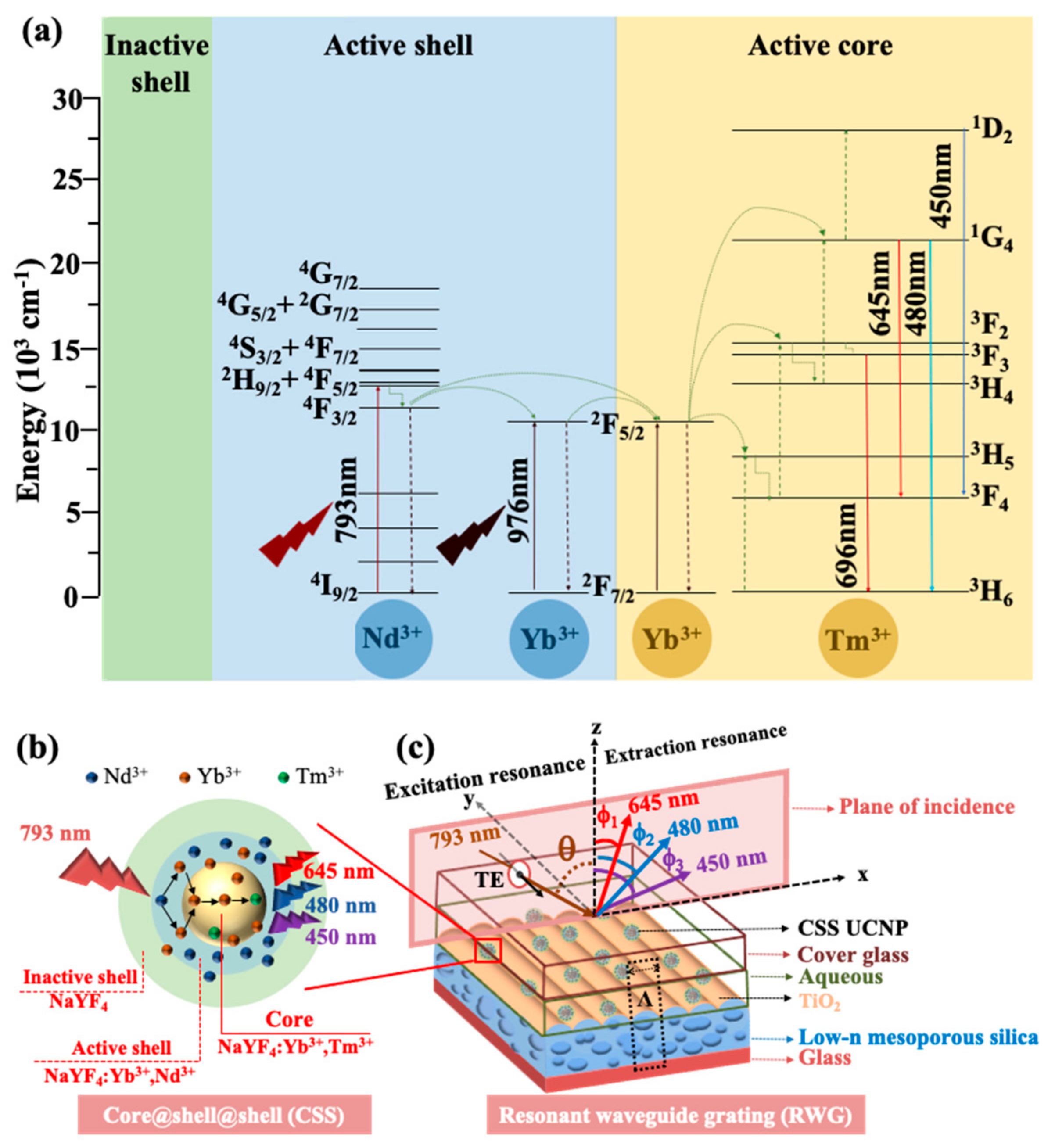
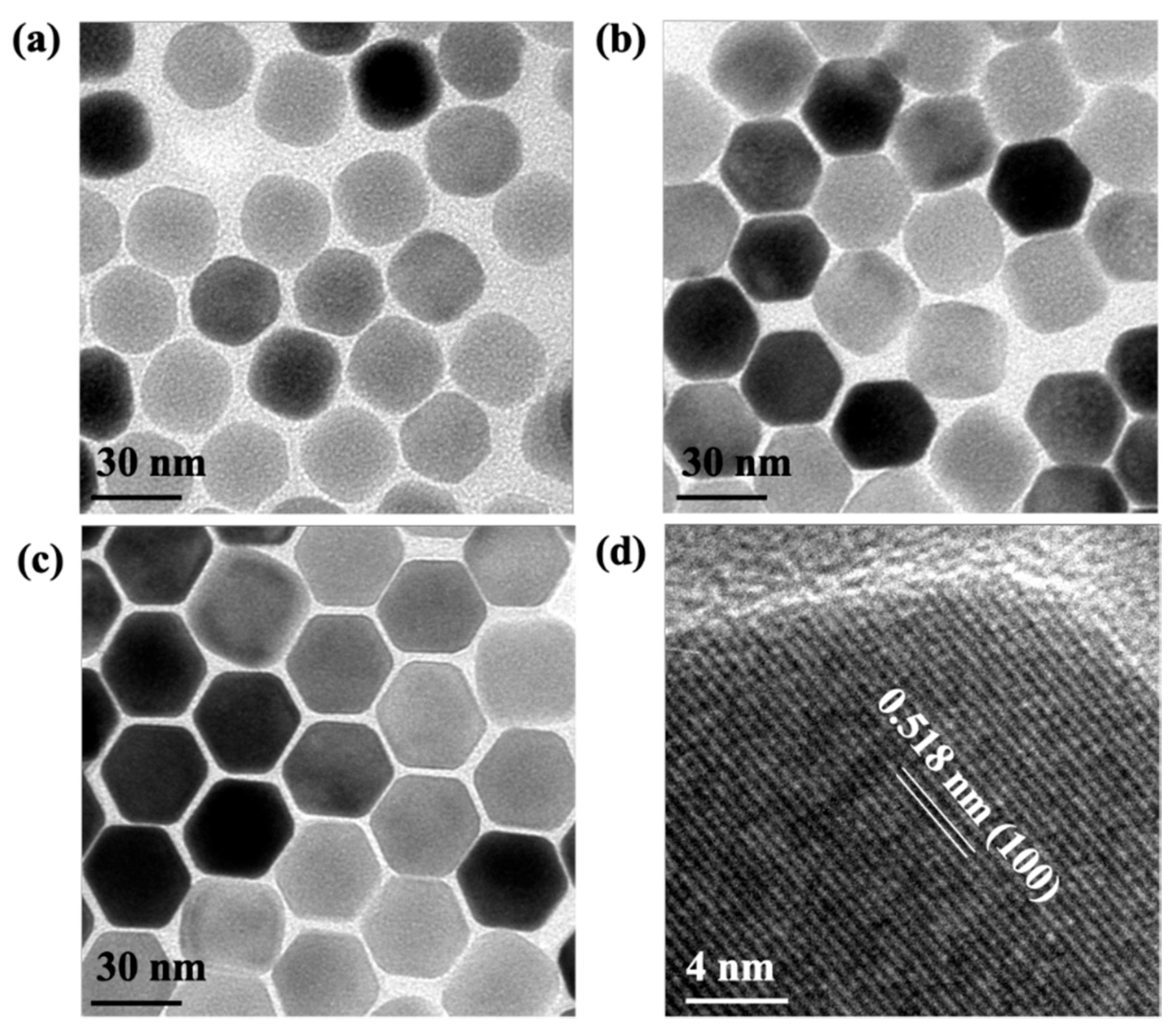
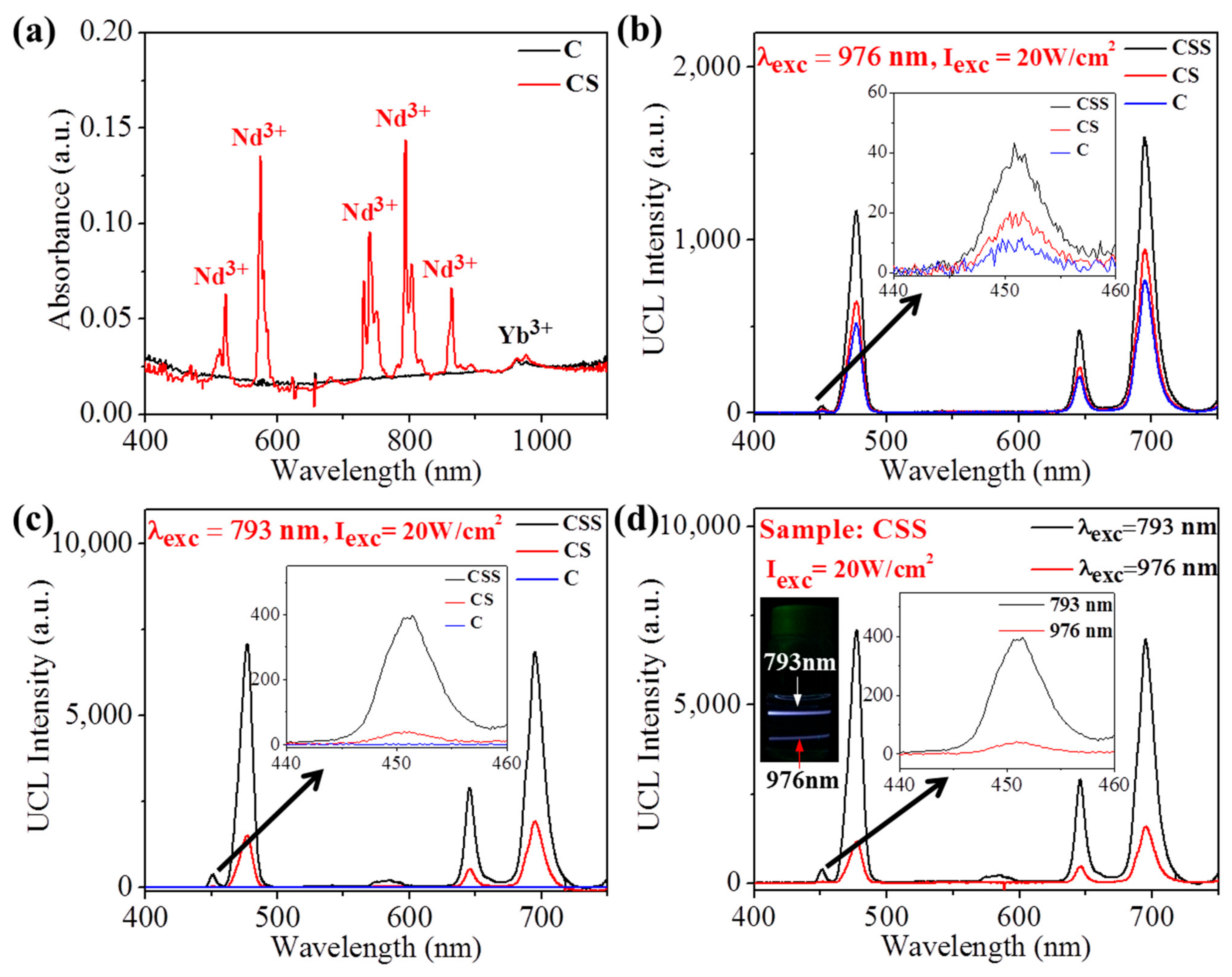
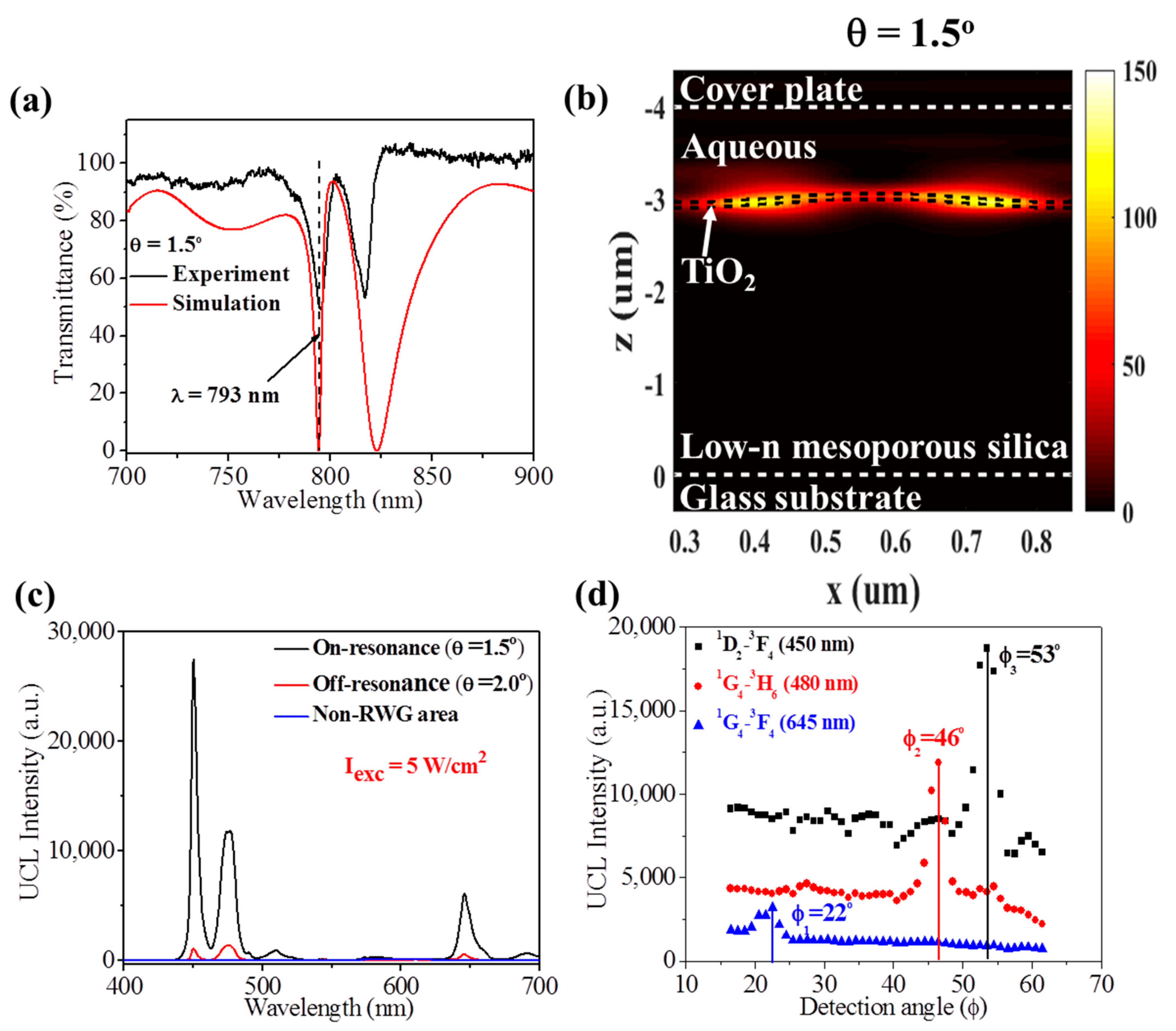
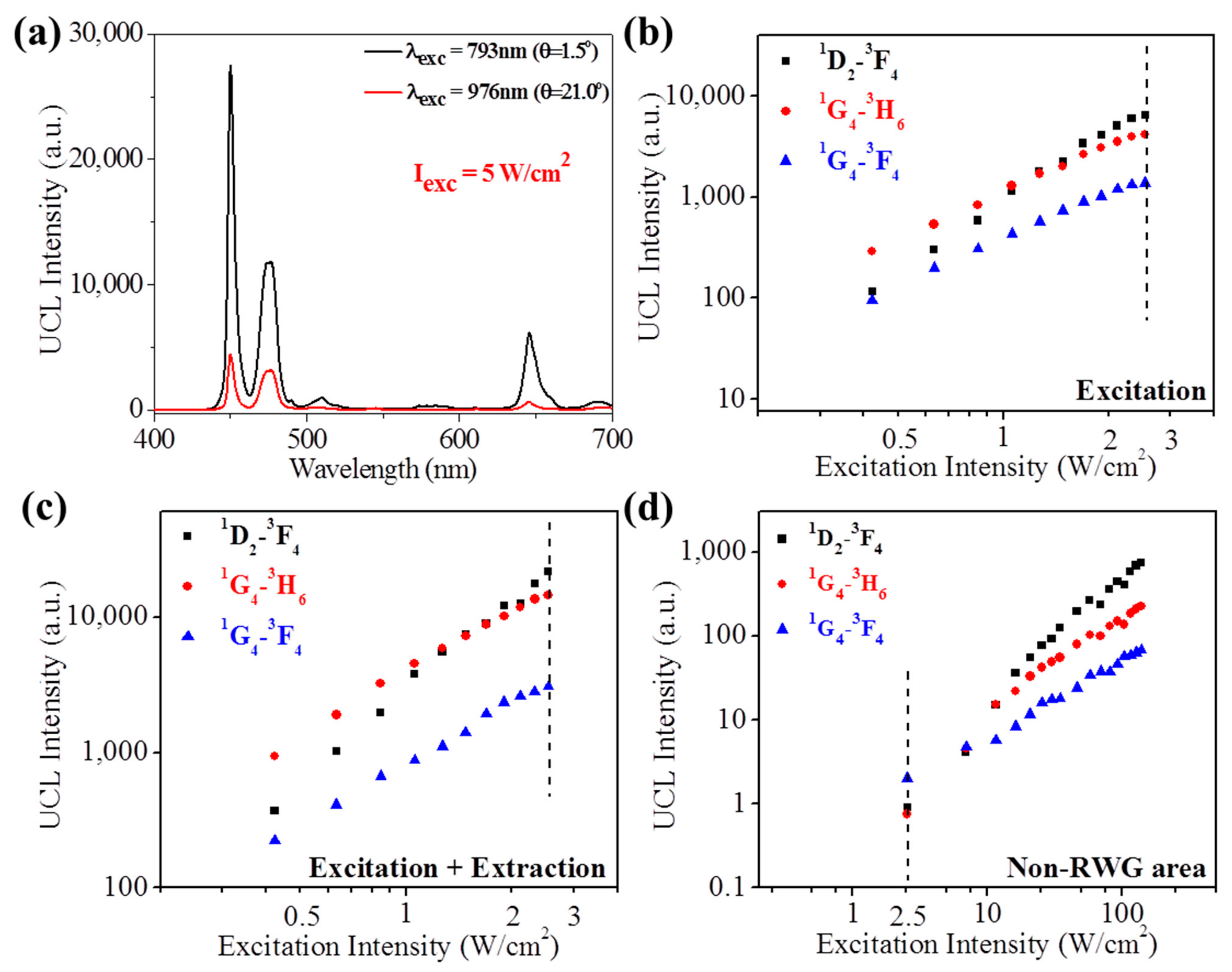
| Enhancement Factor | |||
|---|---|---|---|
| λe (nm) | 450 | 480 | 645 |
| Surface passivation | 4.9 | 2.7 | 2.8 |
| Nd3+ doping | 9.2 | 6.1 | 6.1 |
| Excitation resonance | 7.2 × 103 | 5.5 × 103 | 6.9 × 102 |
| Extraction resonance | 3.4 | 3.5 | 2.4 |
| Total | 1.1 × 106 | 3.2 × 105 | 2.8 × 104 |
Publisher’s Note: MDPI stays neutral with regard to jurisdictional claims in published maps and institutional affiliations. |
© 2021 by the authors. Licensee MDPI, Basel, Switzerland. This article is an open access article distributed under the terms and conditions of the Creative Commons Attribution (CC BY) license (https://creativecommons.org/licenses/by/4.0/).
Share and Cite
Vu, D.T.; Tsai, Y.-C.; Le, Q.M.; Kuo, S.-W.; Lai, N.D.; Benisty, H.; Lin, J.-Y.; Kan, H.-C.; Hsu, C.-C. A Synergy Approach to Enhance Upconversion Luminescence Emission of Rare Earth Nanophosphors with Million-Fold Enhancement Factor. Crystals 2021, 11, 1187. https://doi.org/10.3390/cryst11101187
Vu DT, Tsai Y-C, Le QM, Kuo S-W, Lai ND, Benisty H, Lin J-Y, Kan H-C, Hsu C-C. A Synergy Approach to Enhance Upconversion Luminescence Emission of Rare Earth Nanophosphors with Million-Fold Enhancement Factor. Crystals. 2021; 11(10):1187. https://doi.org/10.3390/cryst11101187
Chicago/Turabian StyleVu, Duc Tu, Yi-Chang Tsai, Quoc Minh Le, Shiao-Wei Kuo, Ngoc Diep Lai, Henri Benisty, Jiunn-Yuan Lin, Hung-Chih Kan, and Chia-Chen Hsu. 2021. "A Synergy Approach to Enhance Upconversion Luminescence Emission of Rare Earth Nanophosphors with Million-Fold Enhancement Factor" Crystals 11, no. 10: 1187. https://doi.org/10.3390/cryst11101187
APA StyleVu, D. T., Tsai, Y.-C., Le, Q. M., Kuo, S.-W., Lai, N. D., Benisty, H., Lin, J.-Y., Kan, H.-C., & Hsu, C.-C. (2021). A Synergy Approach to Enhance Upconversion Luminescence Emission of Rare Earth Nanophosphors with Million-Fold Enhancement Factor. Crystals, 11(10), 1187. https://doi.org/10.3390/cryst11101187









